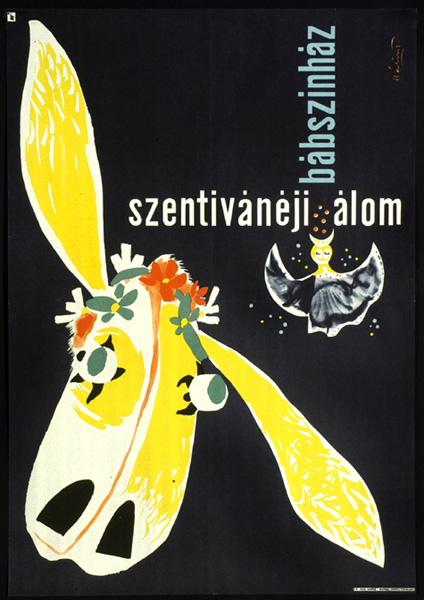

 The roots of Theatre History Collection go back to the establishment of National Széchényi Library. For a long time, further increases in the collection were due to the diligent endeavors of private collectors. These included József Bayer, the first historian of the Hungarian theater, József Szinnyei, Sr., the former director of the Library's Newspaper Collection and two actors, Lajos Fáncsy and Pál Rakodczay. As the result of their endeavors, the collection grew richer and richer with important manuscripts, programs and theatrical reference books. Some of the major contributions include the manuscript collection of the plays of Ede Szigligeti, the famous writer, stage manager and director of Hungary’s National Theater and the heritage of Gábor Egressy, the first great Hungarian Shakespearean actor, as well as of directors György Molnár and Ignác Krecsányi. The latter consist only of theatrical documents.
The roots of Theatre History Collection go back to the establishment of National Széchényi Library. For a long time, further increases in the collection were due to the diligent endeavors of private collectors. These included József Bayer, the first historian of the Hungarian theater, József Szinnyei, Sr., the former director of the Library's Newspaper Collection and two actors, Lajos Fáncsy and Pál Rakodczay. As the result of their endeavors, the collection grew richer and richer with important manuscripts, programs and theatrical reference books. Some of the major contributions include the manuscript collection of the plays of Ede Szigligeti, the famous writer, stage manager and director of Hungary’s National Theater and the heritage of Gábor Egressy, the first great Hungarian Shakespearean actor, as well as of directors György Molnár and Ignác Krecsányi. The latter consist only of theatrical documents.
The Theatre History Collection became an independent unit of NSZL in 1949. The libraries of the theaters surviving World War II remained intact (National Theater, Comedy Theater and People's Theater) and the collections of theater-related organizations (agencies and pension offices) were taken over by the Hungarian state. Their volume and specific character justified the establishment of an independent collection within Hungary’s national library.
Read more
The core of this rich collection is the 30,000-item collection of plays, of which the most valuable items are the director's and prompter's copies of productions staged at the National Theater, Comedy Theater, People's Theater, the Buda and Pest German theaters, the Szomolnok German amateur players group and the Ignác Krecsányi presentations.
The director's copies of the most significant Hungarian directors (Ede Szigligeti, Gábor Egressy, Ede Paulay, György Molnár, Sándor Hevesi and Antal Németh) are written memorials of their activities. They include a large number of censorship copies of the period between 1833 and 1867, as expressive testimonials of the supervisory activities of earlier political powers.
The 380,000-item collection of playbills, programs and minor publications and the 130,000-item image collection provide additional information concerning the performances of these plays.
The most valuable components of the image collection are the 21,000 original stage setting and costume drawings. Their creators include two famous masters of the Esterházy Theater, Pietro Travaglia and Carl Maurer. They are followed in the 19th century, in the National Theater and in the Opera, by György Telepi, Mór Lehman, Ágoston Spannraft and Jenő Kéméndy. The 20th century is represented by the creations of Gusztáv Oláh, Zoltán Fülöp, Tivadar Márk, István Pekáry, Mátyás Varga, Álmos Jaschik, Teréz Nagyajtay, István Köpeczi Bócz, Erzsébet Mialkovszky, Árpád Csányi, Judit Gombár, Gyula Hincz and György Konecsni and Vera Bródy.
The works of Miklós Barabás, József Marastoni and Rudolf Alt are preserved in the graphic arts collection. As far as the number of items is concerned, the largest collection is that of the photographs.
A professional reference library also helps the study of this material. The Theater History Collection’s reference library comprises approximately 8000 theatrical handbooks which represent an essential source material for researchers of the first few decades of the Hungarian theater.
The collection is completed by several large theatrical archives including the Esterházy Theater's material, known as Acta Theatralia, and archives of the National Theater and Comedy Theater.
NSZL’s Theatre History Collection is an excellent source for research in the history of the Hungarian theater and it is also well-known for its memorials of Hungarian performing arts in the neighboring countries.

 The roots of Theatre History Collection go back to the establishment of National Széchényi Library. For a long time, further increases in the collection were due to the diligent endeavors of private collectors. These included József Bayer, the first historian of the Hungarian theater, József Szinnyei, Sr., the former director of the Library's Newspaper Collection and two actors, Lajos Fáncsy and Pál Rakodczay. As the result of their endeavors, the collection grew richer and richer with important manuscripts, programs and theatrical reference books. Some of the major contributions include the manuscript collection of the plays of Ede Szigligeti, the famous writer, stage manager and director of Hungary’s National Theater and the heritage of Gábor Egressy, the first great Hungarian Shakespearean actor, as well as of directors György Molnár and Ignác Krecsányi. The latter consist only of theatrical documents.
The roots of Theatre History Collection go back to the establishment of National Széchényi Library. For a long time, further increases in the collection were due to the diligent endeavors of private collectors. These included József Bayer, the first historian of the Hungarian theater, József Szinnyei, Sr., the former director of the Library's Newspaper Collection and two actors, Lajos Fáncsy and Pál Rakodczay. As the result of their endeavors, the collection grew richer and richer with important manuscripts, programs and theatrical reference books. Some of the major contributions include the manuscript collection of the plays of Ede Szigligeti, the famous writer, stage manager and director of Hungary’s National Theater and the heritage of Gábor Egressy, the first great Hungarian Shakespearean actor, as well as of directors György Molnár and Ignác Krecsányi. The latter consist only of theatrical documents.


